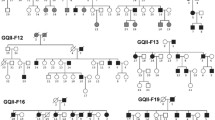Abstract
Atopy and asthma are complex genetic diseases resulting from the interactions of a number of genetic and environmental factors. We had previously reported allelic association between the IL9 marker on chromosome 5q31–33 and atopy. In order to further investigate the role of susceptibility genes on 5q31–33 in the development of atopy and asthma we have studied 240 UK families comprising 131 families selected at random, 60 multiplex families with affected sib pairs, and 49 single proband nuclear families. Polymorphic markers on 5q31–33 were genotyped and both single and multipoint linkage analysis was undertaken using the BETA program. We have used both affection status and quantitative scores for atopy and asthma for phenotypic variables, combining data into scores for asthma and atopy. The strongest suggestion of linkage using multipoint analysis was centred around D5S410 with a maximum Lod of 1.946 at location 171.3 cM and a standard error of 3.3 for the asthma quantitative score. There was no evidence of linkage with atopy, the atopy quantitative score or total serum IgE.
Similar content being viewed by others
Author information
Authors and Affiliations
Corresponding author
Rights and permissions
About this article
Cite this article
Holloway, J., Lonjou, C., Beghé, B. et al. Linkage analysis of the 5q31–33 candidate region for asthma in 240 UK families . Genes Immun 2, 20–24 (2001). https://doi.org/10.1038/sj.gene.6363723
Published:
Issue Date:
DOI: https://doi.org/10.1038/sj.gene.6363723
- Springer Nature Limited
Keywords
This article is cited by
-
Identification of novel candidate variants including COL6A6 polymorphisms in early-onset atopic dermatitis using whole-exome sequencing
BMC Medical Genetics (2017)
-
KIF3A, a Cilia Structural Gene on Chromosome 5q31, and Its Polymorphisms Show an Association with Aspirin Hypersensitivity in Asthma
Journal of Clinical Immunology (2011)
-
A new association between polymorphisms of the SLC6A7 gene in the chromosome 5q31–32 region and asthma
Journal of Human Genetics (2010)
-
Genetics of susceptibitlity to human infectious disease
Nature Reviews Genetics (2001)



